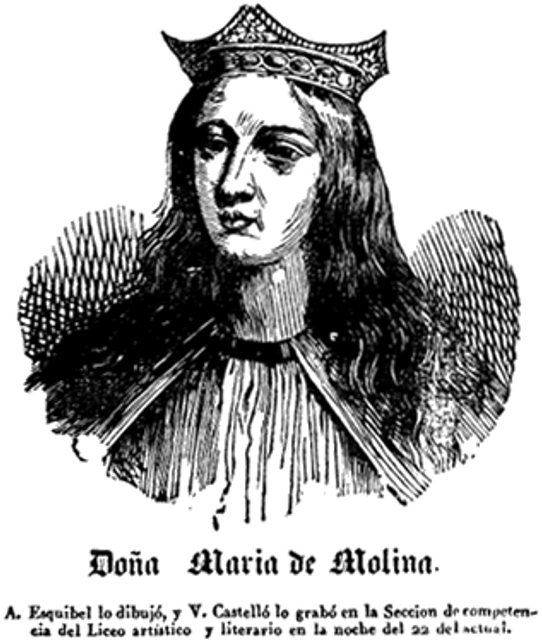María de Molina

María de Molina

| María de Molina | |||||
|---|---|---|---|---|---|
| Queen consort of Castile and León | |||||
| Reign | 1284–1295 | ||||
| Born | c. 1265 | ||||
| Died | 1 July 1321 Valladolid | ||||
| Burial | Santa María la Real de las Huelgas (Valladolid) | ||||
| Spouse | Sancho IV of Castile | ||||
| Issue among others... | Isabella, Queen of Aragon Ferdinand IV, King of Castile Beatrice, Queen of Portugal | ||||
| |||||
| House | Castilian House of Ivrea | ||||
| Father | Alfonso of Molina | ||||
| Mother | Mayor Alfonso de Meneses | ||||
| Religion | Roman Catholicism | ||||
| Full name | |||||
| María Alfonso de Meneses | |||||

Coat of Arms as Queen of Castile
María Alfonso Téllez de Meneses (c. 1265 – 1321), known as María de Molina, was queen consort of Castile and León from 1284 to 1295 by marriage to Sancho IV of Castile, and served as regent for her minor son Ferdinand IV (1295 - c.1301) and later her grandson Alfonso XI of Castile (1312-1321).
| María de Molina | |||||
|---|---|---|---|---|---|
| Queen consort of Castile and León | |||||
| Reign | 1284–1295 | ||||
| Born | c. 1265 | ||||
| Died | 1 July 1321 Valladolid | ||||
| Burial | Santa María la Real de las Huelgas (Valladolid) | ||||
| Spouse | Sancho IV of Castile | ||||
| Issue among others... | Isabella, Queen of Aragon Ferdinand IV, King of Castile Beatrice, Queen of Portugal | ||||
| |||||
| House | Castilian House of Ivrea | ||||
| Father | Alfonso of Molina | ||||
| Mother | Mayor Alfonso de Meneses | ||||
| Religion | Roman Catholicism | ||||
| Full name | |||||
| María Alfonso de Meneses | |||||
Biography
María was the daughter of the infante Alfonso of Molina and Mayor Alfonso de Meneses. Her paternal grandparents were King Alfonso IX of León and Queen Berengaria of Castile.[1]
Queen

Maria de Molina presents her son Ferdinand IV to Cortes de Valladolid in 1295. Painting of Antonio Gisbert Pérez, 1863, Congreso de los Diputados de España, Madrid.
She married her second cousin Sancho IV of Castile in 1282, the second son of Alfonso X the Learned, although the matrimonial dispensation for kinship was not previously granted. Upon the death of Alfonso X, she became queen consort of Castile and León and was crowned alongside her husband in the cathedral of Toledo. Although the couple was pressured to separate by Rome and others, Sancho chose to honor his wife and delegated many responsibilities to her, including the regency of their son after his death. His reign was short since he died in 1295.
First regency
After the death of Sancho IV, he was succeeded by their eldest son Ferdinand IV, who was under age. Though according to the Crónica de Sancho IV, Sancho designated María as the sole regent,[2] she was forced to share the regency with Sancho's uncle, Henry the Senator, younger brother of Alfonso X. Ferdinand's rule was challenged by a coalition that included his uncle, John, his cousins the infantes de la Cerda, sons of the infante Ferdinand de la Cerda, eldest son of Alfonso X, as well as King James II of Aragón and King Denis of Portugal.[3][4]
Through marriage alliances, gifts of territories, and shrewd politics María was able to lead Ferdinand's cause to victory, though it did not come easily. María built her own coalition, relying on the Castilian Cortes to confirm her authority and playing the powerful family of Haro against the Laras, who supported the opposition. Civil war continued for several years, and María's coregent Henry was often more of an antagonist than a defender of his great-nephew's cause.
Around 1300 the alliance against Ferdinand began to crumble when one of his principal enemies, Juan Núñez de Lara, was captured and later reconciled to the young king. Portugal returned to allegiance with Ferdinand with the promise of a marriage between the Portuguese princess Constance and the young king of Castile. María's victory for her son seemed sealed in 1301, when she finally received a papal bull from Pope Boniface VIII, legitimizing her marriage and her children. Eventually, only Aragon was left to support the claim of Alfonso de la Cerda and his brother, which was finally set aside in a treaty between Castile and Aragon a few years later.
Second regency
Upon the death of her son in 1312, he was succeeded by his son, the grandson of Maria. As the new king was a minor, a regency would be needed during his minority. Maria became regent of Castile for a second term, now as guardian regent for her minor grandson.
María de Molina died in Valladolid in 1321.
Children
Isabella of Castile (1283–1328). Married first James II of Aragon and secondly John III, Duke of Brittany.
Ferdinand IV of Castile (1285–1312). Married Constance of Portugal.
Alfonso (1286–1291)
Henry (1288–1299)
Peter (1290–1319). Married Maria of Aragon, daughter of James II of Aragon.
Philip (1292–1327). Married his cousin Margarita de la Cerda, daughter of Ferdinand de la Cerda, Infante of Castile.
Beatrice of Castile (1293–1359). Married Afonso IV of Portugal.